ALICIA NATIONAL HIGH SCHOOL Alicia, Isabela Subsets of a Line Background Information for Learners Line is an infinitely thin, infinitely long collection of points extending in two opposite directions. When we draw lines in geometry, we use an arrow at each end to show that it extends infinitely. A B c A line can be named either using two points on the line (for example, AB, BA, c) or simply by letter, Usually lowercase (for example , line b). A line segment is a subset of a line having two endpoints. It contains these endpoints and all the points of the line between them. You can measure the length of a segment. A B A segment is named by its two endpoints, for example, AB, BA A ray is a part of a line that has one endpoint and goes on infinitely in only one direction. You cannot measure the length of a ray. A B A ray is named using the endpoint first, and then any other point on the ray, for example, AB.
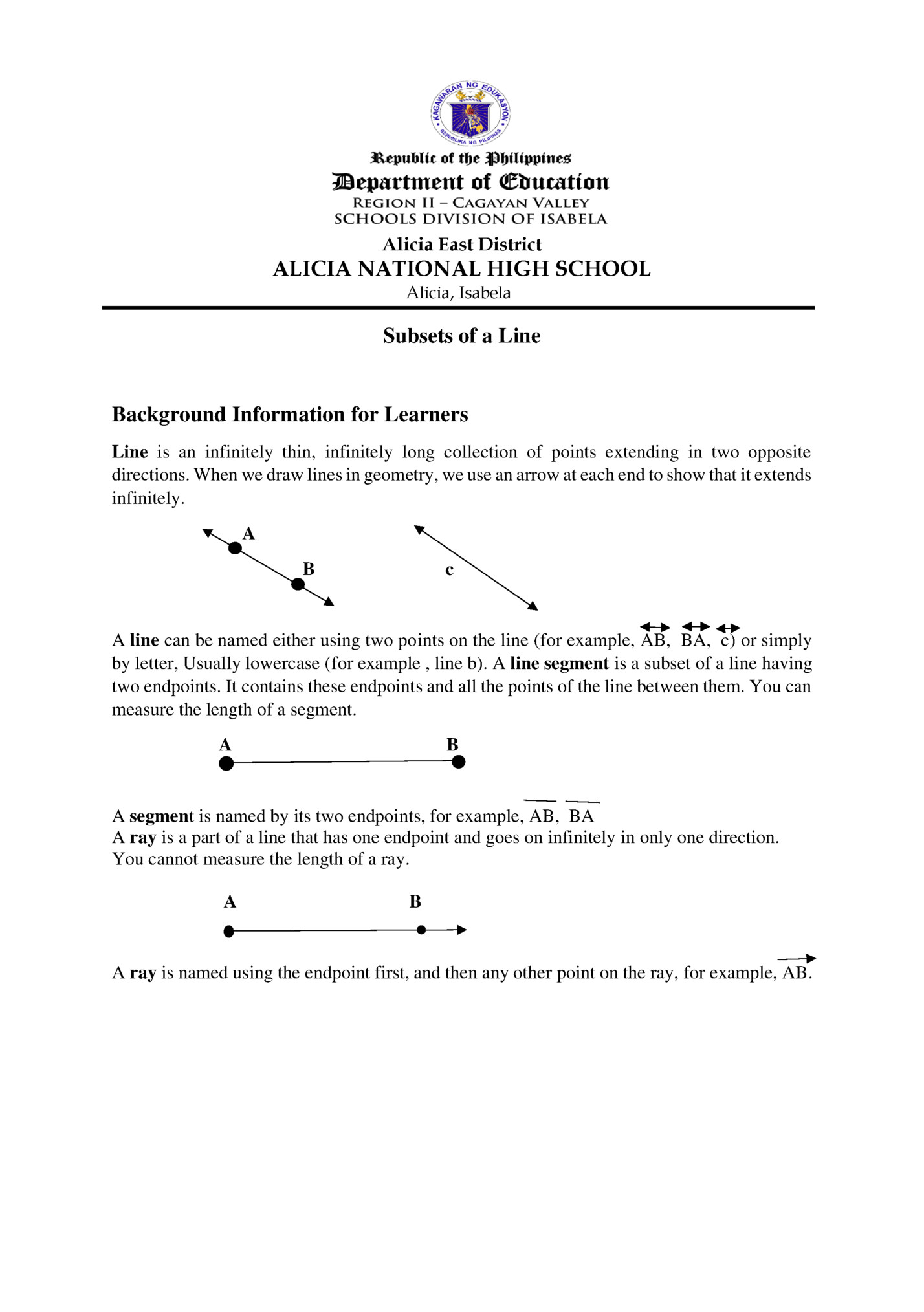
Illustrates subsets of a line – M7GE-IIIa- 2 EXERCISES: 1. How many line segments can be drawn through two given points? A. One B. Two C. Three D. Four 2. How many rays are possible through a given point? A. Ten B. Twenty C. None D. Infinite 3. What subset of a line consists of two endpoints and all the points in between? A. line B. plane C. segment D. ray 4. What is the relationship of line m to line line n? m 6cm A. congruent with each other B. bisects each other C. intersect each other D. transversal with each other n 6cm 5. Which of the following figures show a ray? A. C. B. D. Prepared by: ALICIA C. DOMINGO Writer/Subject Teacher Checked: JOVITA E. BRILLO, MT2 Mathematics Coordinator Noted: ELEANOR A. ISIDRO, EdD Principal 4
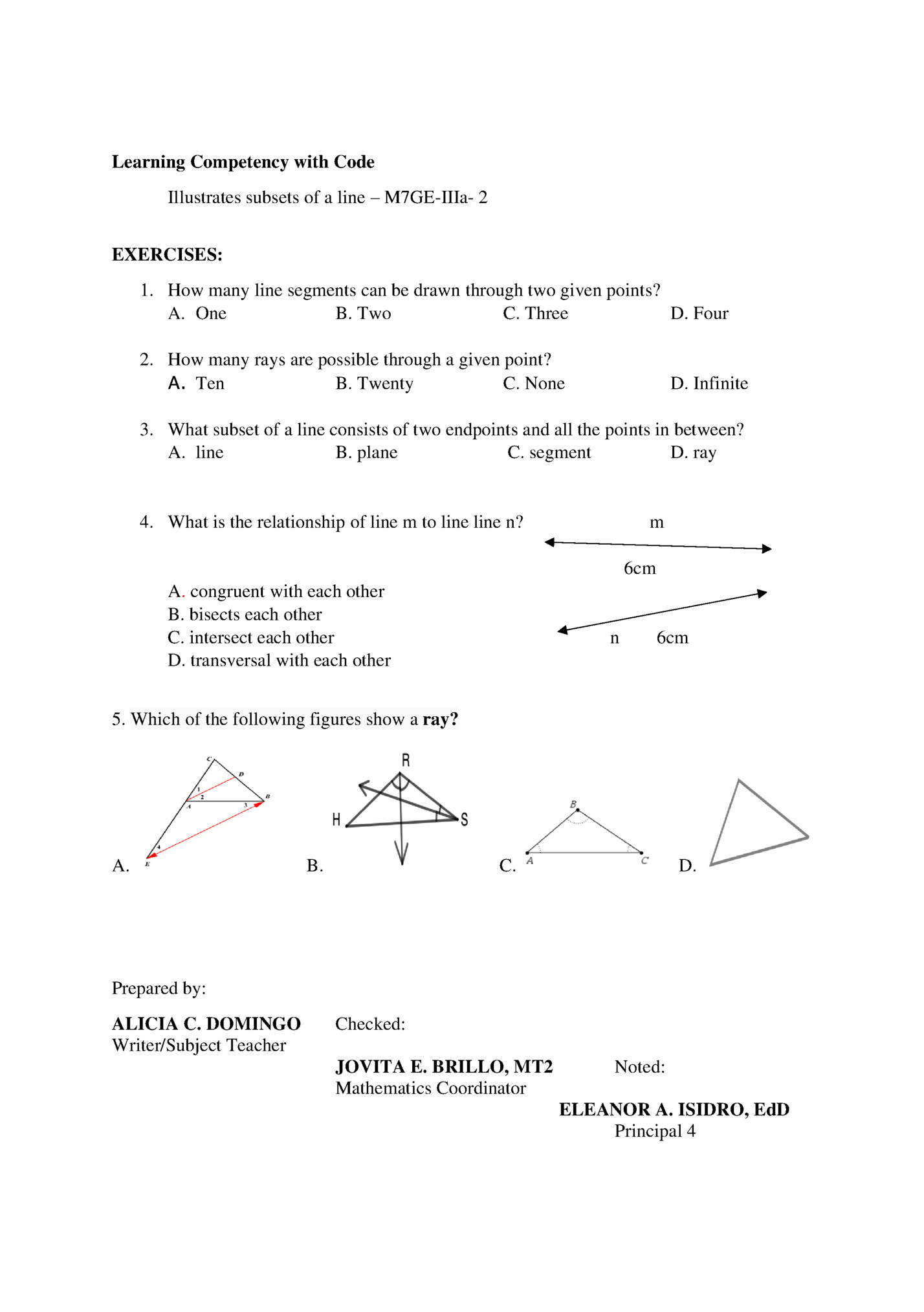
ALICIA NATIONAL HIGH SCHOOL Alicia, Isabela Angles Formed by Parallel Lines Cut by a Transversal Background Information for Learners A transversal is a line intersecting two or more coplanar lines at different points. If parallel lines are cut by a transversal, then eight angles and pairs of angles are formed. 7 8
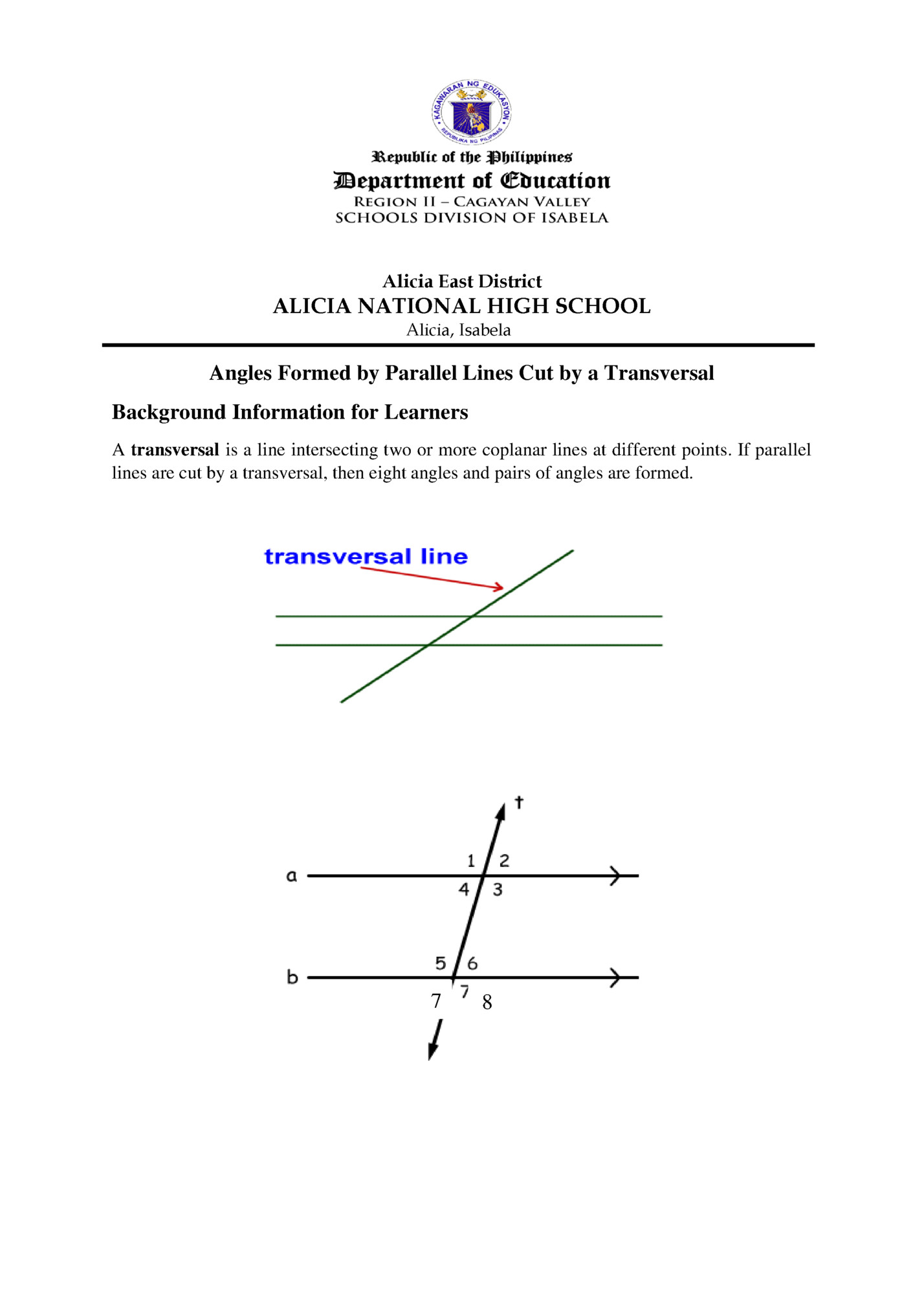
A pair of non-adjacent interior and exterior angles on the same side of a transversal. The pairs of corresponding angles are: ∠1 and ∠5; ∠4 and ∠7; ∠2 and ∠6; ∠3 and ∠8. Interior Angles Angles that lie on the interior of the parallel lines cut by a transversal. The Interior angles are ∠4, ∠3, ∠5, and ∠6. Alternate Interior Angles A pair of non-adjacent interior angles on opposite sides of a transversal. The pairs of alternate interior angles are: ∠4 and ∠6; ∠3 and ∠5. Same-Side Interior Angles Interior angles on the same side of the transversal. The pairs of same-side interior angles are: ∠4 and ∠5; ∠3 and ∠6. Exterior Angles Angles that lie on the exterior of the parallel lines cut by a transversal. The Exterior angles are ∠1, ∠2, ∠7, and ∠8. Alternate Exterior Angles A pair of non-adjacent exterior angles on opposite sides of a transversal. The pairs of alternate exterior angles are: ∠1 and ∠8; ∠2 and ∠7. Same-Side Exterior Angles Exterior angles on the same side of the transversal. The pairs of same-side interior angles are: ∠1 and ∠7; ∠2 and ∠8. Learning Competency with Code Derive relationships among angles formed by parallel lines cut by a transversal using measurement and by inductive reasoning. M7GE-IIIc-1. Observe the measure of the angle pairs. Example: Find the measure of all angles if the measure of ∠2 = 22x – 5, and ∠3 = 7x + 10.

Find the value of x. Since ∠2 and ∠3 are of equal measurements, 22x – 5 = 7x + 10 Corresponding angles 22x – 7x = 5 + 10 Combining like terms 15x = 15 Divide both sides by 3. x=1 Substituting the value of x to the given expression, ∠2 = 22x – 5 ∠3 = 7x + 10 ∠2 = 22(1) – 5 ∠3 = 7(1) + 10 ∠2 = 22 – 5 ∠3 = 7 + 10 ∠2 = 17º ∠3 = 17º To find the value of ∠1, Since ∠1 and ∠2 is supplementary, therefore, ∠1 + 17º = 180º Supplementary Angles ∠1 = 180º - 17º combining like terms ∠1 = 163º 22(1) - 5 =17⁰ 163⁰ 7(1) +10 =17⁰ 163⁰ 17⁰ 163⁰ 17⁰ 163⁰

1. In the following figure of two intersecting lines, what is the measure of ∠2? 142⁰ Angle 2 A. 38⁰ B. 58⁰ D. 142⁰ C. 68⁰ Use the following diagram of parallel lines cut by a transversal to answer questions 2 through 5. 45⁰ ⁰ 2. What is the measure of ∠8? A. 45⁰ B. 55⁰ C. 145⁰ D. 155⁰ 3. What is the measure of ∠3? A. 45⁰ B. 55⁰ C. 145⁰ D. 155⁰ 4. What is the measure of ∠6? A. 45⁰ B. 55⁰ C. 145⁰ D. 155⁰ 5. What type of angle pair is ∠1 and ∠5? A. alternate interior angles C. corresponding angles B. supplementary angles D. alternate exterior angles Prepared by: ALICIA C. DOMINGO Writer/Subject Teacher Checked: JOVITA E. BRILLO, MT2 Mathematics Coordinator Noted: ELEANOR A. ISIDRO, EdD Principal 4

ALICIA NATIONAL HIGH SCHOOL Alicia, Isabela ANGLE RELATIONSHIPS Background Information for Learners Geometry is a branch of mathematics that deals with questions of shape, size, relative position of figures, and the properties of space. It is practically dealing with lengths, areas, and volumes. Fundamental concepts in geometry includes point, line, plane, distance, angle, surface, and curve. The learners will derive the relationship of geometric figures using measurements and inductive reasoning on supplementary angles, complementary angles, vertical angles, adjacent angles, linear pairs, perpendicular lines, and parallel lines. Learning Competency with Code: Derive relationships of geometric figures using measurements through inductive reasoning; supplementary angles, complementary angles, congruent angles, vertical angles, adjacent angles, linear pairs, perpendicular lines, and parallel lines (M7GE-IIIb-1) MATHEMATICAL TERMS: Supplementary angles refer to the pair of angles that always sum up to 180°. These two angles are called supplements of each other. These two angles are Complementary Angles, because they add up to 90°: Notice that together they make a right angle Adjacent angles are two angles that have a common side and a common vertex (corner point) but do not overlap in any way. .
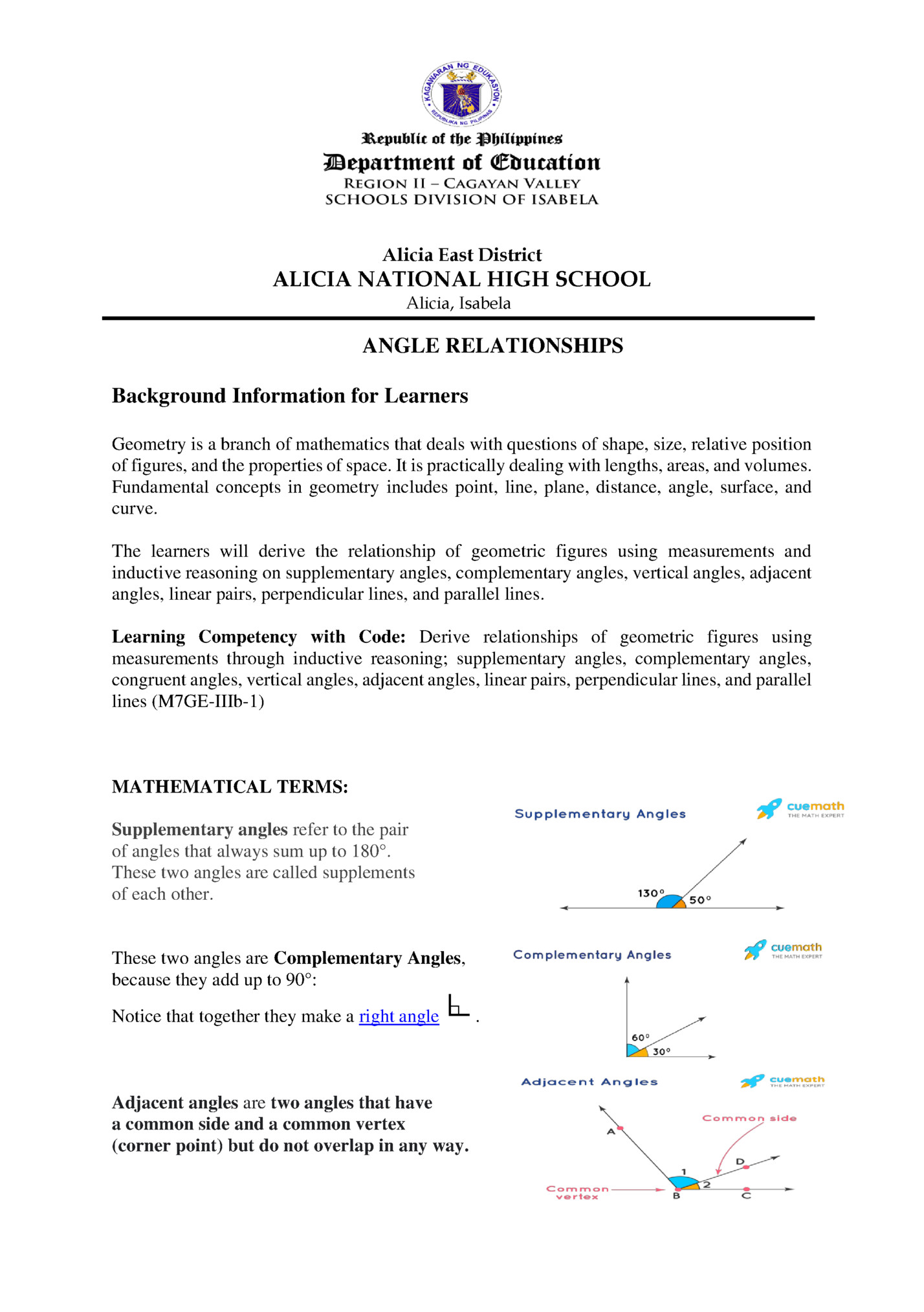
equal measurement. Vertical Angles. Non- adjacent angles formed by two intersecting lines with equal angles. Linear Pairs. Formed when two lines intersect. The measure of a straight angle is 180 degrees, so a linear pair of angles must add up to 180 degrees. Perpendicular Lines. These are intersecting lines forming right angles. Parallel Lines. These are lines in a plane which do not meet.

1. What Are vertical angels? A. Angles that are adjacent to each other B. Angles that are opposite of each other when liness intersect C. Angels that add up to 180⁰ D. Ngles that add up to 90⁰ 2. What is the supplement angle to 45⁰ A. 45⁰ B. 100⁰ C. 135⁰ D. 180⁰ 3. What is the compliment angle to 12⁰? A. 68⁰ B. 78⁰ C. 90⁰ D. 168⁰ 4. Which phrase is incorrect? A. Complementary anlges have to be adjacent. B. Complementary angled can make a right triangle C. Supplementary anges equal 180⁰ D. Supplementary angles add up to be half of 180⁰ 5. Is it possible to find the complement angle of 103⁰? If so, what is it? A. Yes, the compliment angle is 77⁰ B. Yes, the compliment angle is 83⁰ C. Yes, the compliment angle is 13⁰ D. Not possible Prepared by: ALICIA C. DOMINGO Writer/Subject Teacher Checked: JOVITA E. BRILLO, MT2 Mathematics Coordinator Noted: ELEANOR A. ISIDRO, EdD Principal 4
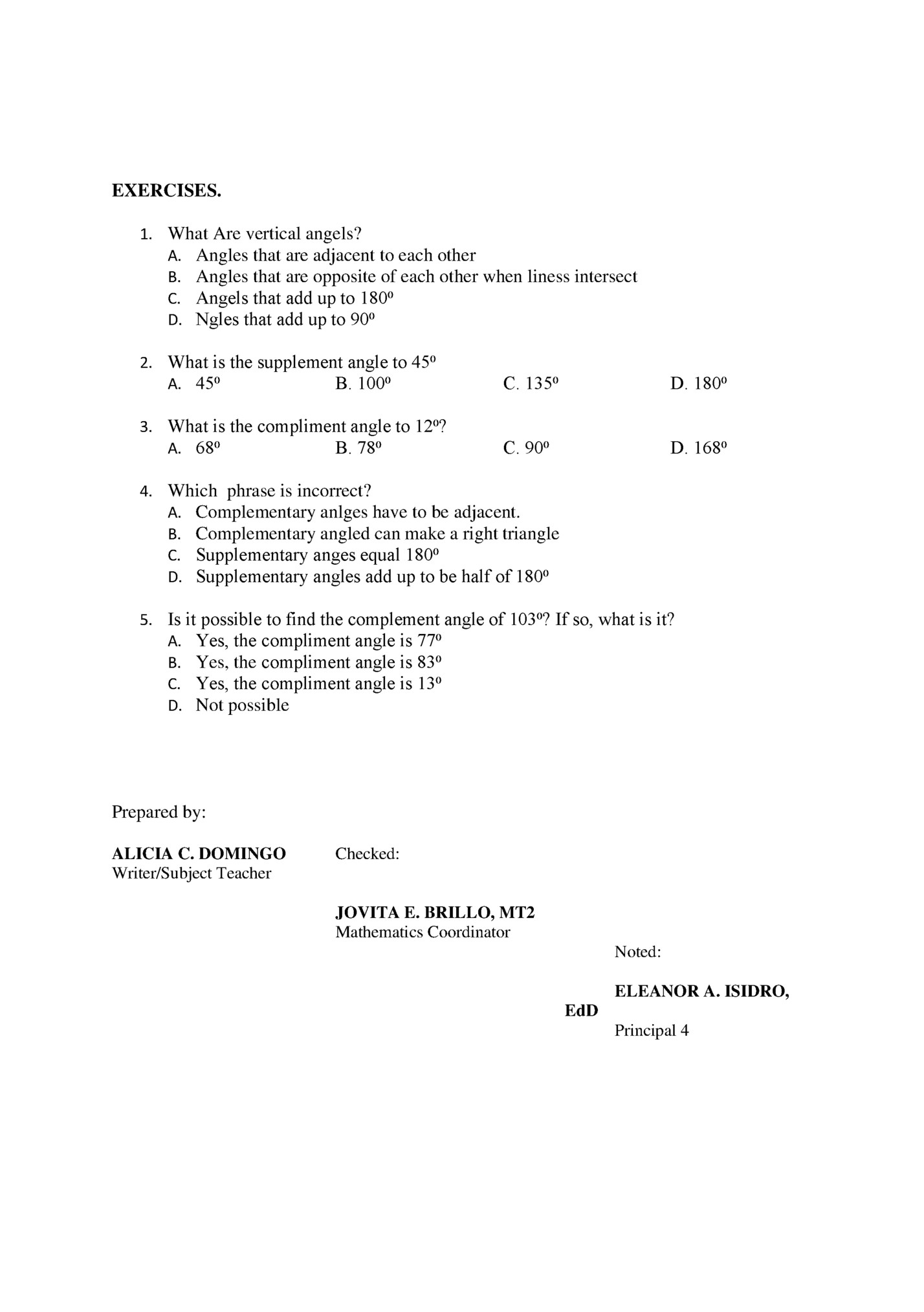
Fleepit Digital © 2021